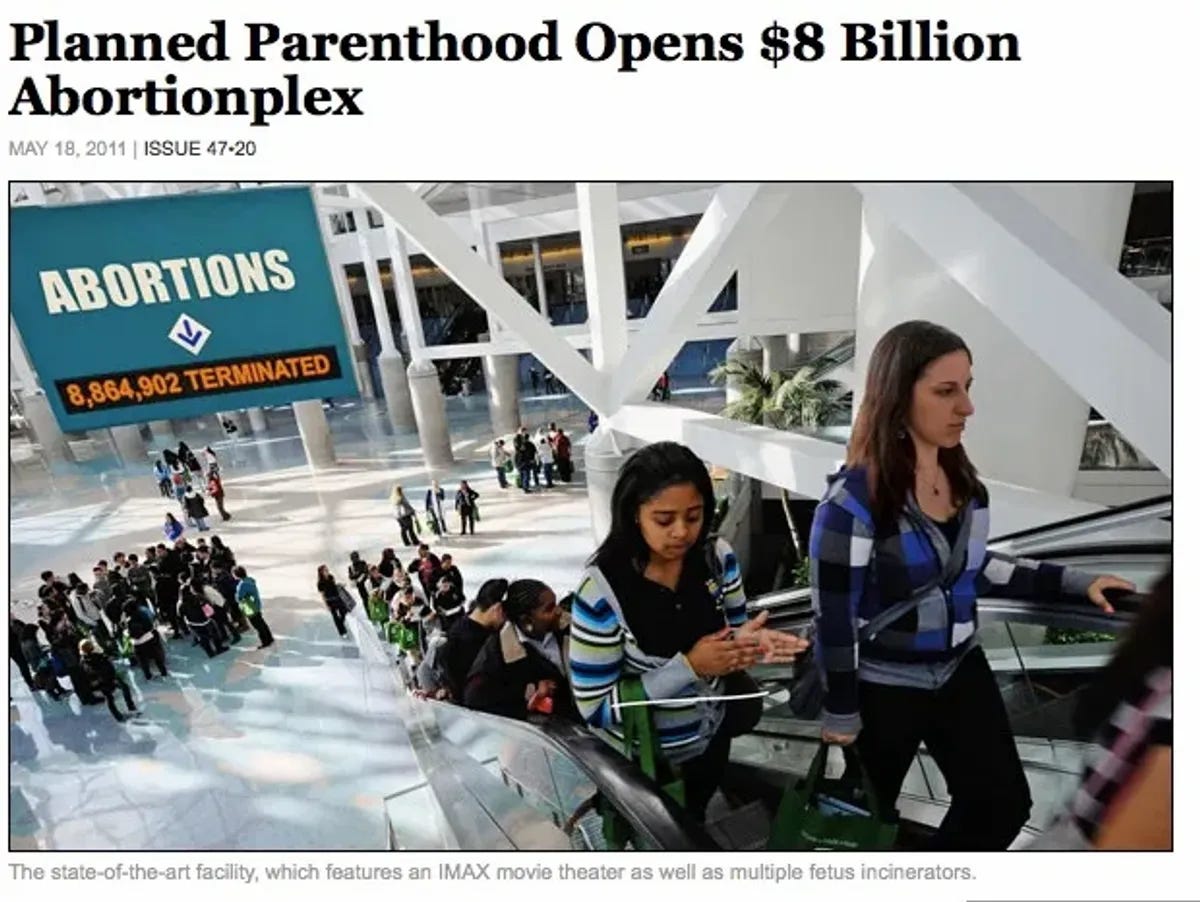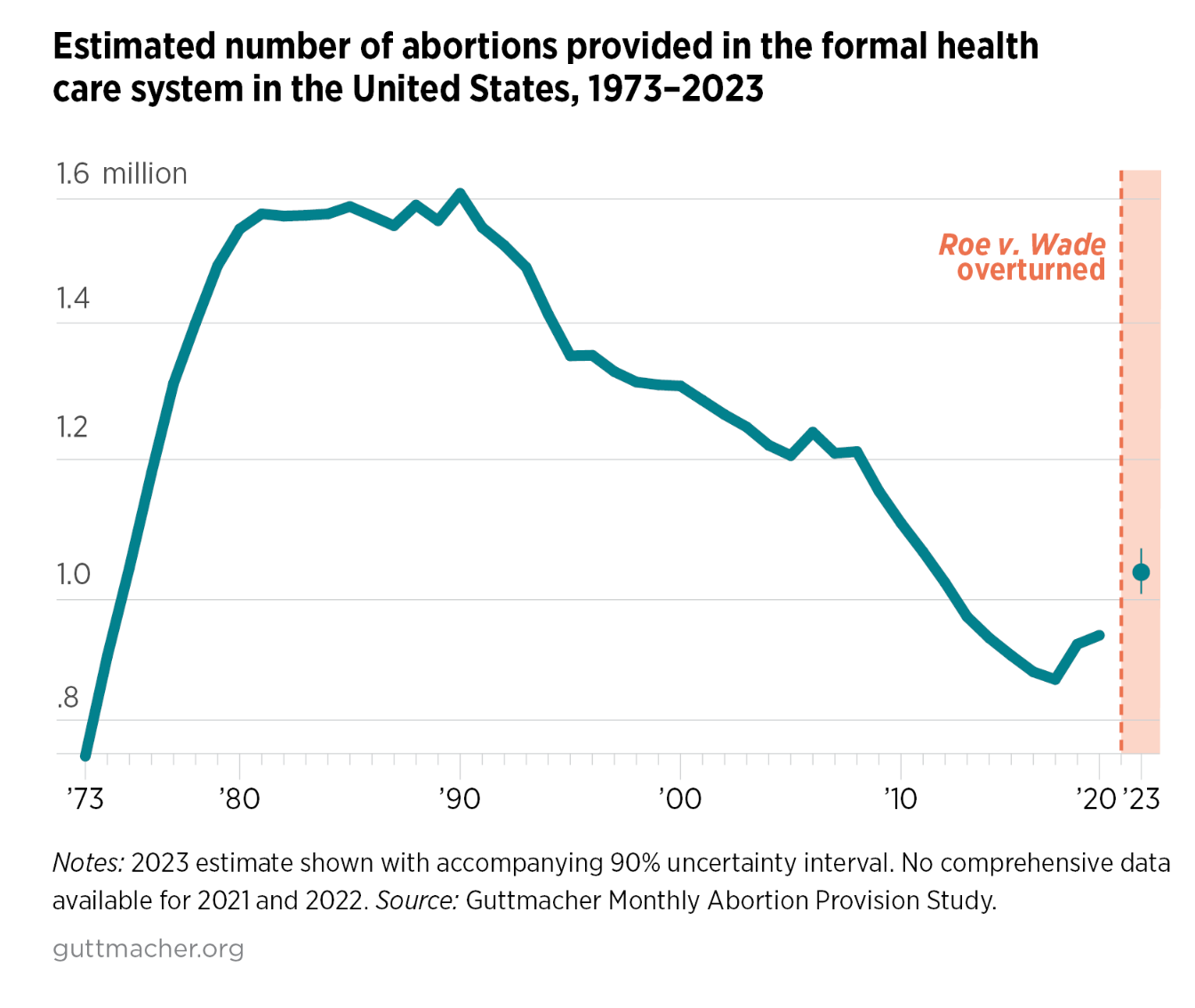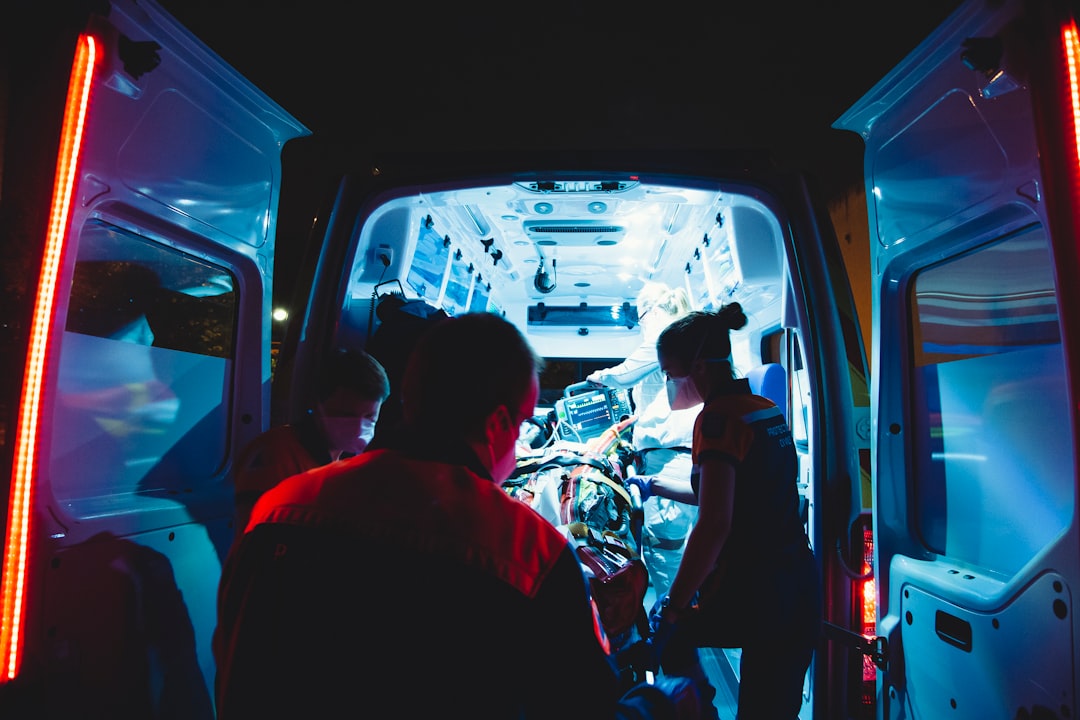Post-Roe America Is A Regular Ol' Abortionpalooza
There are more abortions now than there have been in a decade.
In June of 2022, the Supreme Court overturned Roe v. Wade. Since then, 14 states have gone ahead and banned abortion.
And yet, according to a report released by the Guttmacher Institute on Tuesday, there were actually more abortions in 2023 than there had been in over a decade, with a 10 percent increase since 2020. The sexual and reproductive health organization estimates that there were 1,026,690 abortions last year, which would actually be the highest number of abortions since 2012, when Obama forced all the insurance companies to cover birth control entirely. (No, we don’t mean Obamacare forced insurance companies to cover abortion.)
Some might take this to mean that accessible birth control is a more effective way of reducing the number of abortions than abortion bans are.
I’m not entirely surprised. Before Roe was overturned, abortion was just as inaccessible to many people as if it had been illegal. Some states only had one or two clinics and required multi-day waiting periods in order to actually get an abortion — which meant travel expenses, missing days at work, often needing to find and pay for childcare and other financial barriers. Now there’s simply more infrastructure. There’s more money in abortion funds meant to help women and others travel to get abortions, meaning that abortion is actually more accessible to them now than it was before. At least 160,000 of the abortions in 2023 were performed on women who traveled from states with bans.
As the report explains:
In part, this is because the drastic loss of access in states with bans has been counterbalanced by monumental efforts on the part of clinics, abortion funds and logistical support organizations to help people in ban states access care through financial and practical support. States bordering ban states had particularly large increases. In total, abortions in these states increased by 37% between 2020 and 2023, with particularly sharp increases in Illinois (38,010 more abortions than in 2020, or an increase of 72%), New Mexico (15,090 more abortions, an increase of 257%), Virginia (14,190, an increase of 76%) and North Carolina (12,970, or 41%). Much of the increase in these states was due to increased travel across state lines. Illinois, for example, provided abortion care to an estimated 25,660 more patients from out of state, accounting for 68% of its overall increase.
It’s also quite likely that a lot of women in abortion ban states who might have otherwise chosen to go through with their pregnancy have instead decided to travel to get an abortion, simply because they do not trust that if something goes wrong with their pregnancies they can rely on their doctors to keep them safe. I wouldn’t blame them for one second. On that note, there are not statistics on illegal self-managed abortions in these states — possibly by purchasing misoprostol in Mexico where it is available over-the-counter — which could be a lot higher than anyone realizes.
As the Guttmacher Institute points out, many states have responded to Dobbs overturning Roe v. Wade by passing laws that made abortion even more accessible to their own residents.
“It is very possible that, while access was dramatically curtailed for people living in ban states, access substantially improved for residents of states without bans,” the report explained.
Another reason for the increase is the availability and accessibility of medication abortion, particularly through telehealth providers. Even in states where abortion rights are protected, there are rural areas where people don’t have immediate access to an abortion provider, and this certainly helps with that.
As much as we’d all like to go “Haha! Take that, you anti-abortion freaks! Your stupid plans failed!” and bask in the schadenfreude of it all, this doesn’t mean that these bans are not harmful. Because they absolutely are, especially for the most vulnerable populations — and not even just for those seeking abortion.
Communities of color, LGBTQ+ people, young people, immigrants, people living with low incomes and those living with disabilities already contend with multiple barriers to accessing care. Anti-abortion policies exacerbate the health inequities these communities face. For example, states with abortion restrictions on the books have fewer maternal care providers and higher maternal death rates, both of which especially harm Black and Brown people.
Who is going to deliver all of the babies they’re forcing people to have if all of the obstetricians are booking it out of town because they don’t want to have to choose between the welfare of their patients and serious jail time?
When Roe was overturned, people went bananas donating to organizations like the National Network of Abortion Funds — but donations have slowed since then, while need has only increased. We have to keep remembering to give our support to groups like these (however we can) even when it is not a time of national outrage and solidarity.
PREVIOUSLY:








>> As much as we’d all like to go “Haha! Take that, you anti-abortion freaks! Your stupid plans failed!” and bask in the schadenfreude of it all, this doesn’t mean that these bans are not harmful. <<
Abortion is complex as hell. While we want uninterrupted access, **MOST** abortions represent situations that you and I would really rather have addressed through working birth control. Whether it's rape or failed birth control or poor birth control access or whatever, the vast majority of times it would be easier if the person could safely and easily use a reliable BC method.
But this doesn't mean we can just trade in all abortion access for good BC access. Whether one can safely and easily access BC isn't just about public policy, but also about religion and internalized sexism and family violence. And even if those things weren't factors, sometimes you can't use BC b/c you want a child, but then something goes wrong with your health or the pregnancy or the fetus and abortion is the best, healthiest option.
I'd love to see abortion rates go down if it was paired with a reduction in family violence designed to control access to BC, universal health coverage, better and non-stigmatizing awareness campaigns regarding BC and how it can be used to the advantage of any person with any gender and any body.
But if they're going up right now, at least we have accurate information about it, and who is in need so that we have a better chance to help.
In short, abortion is a big deal, but it's interwoven with a host of other issues, and all this is too important and too complicated for me to feel any schadenfreude in the first place.
>>Communities of color, LGBTQ+ people, young people, immigrants, people living with low incomes and those living with disabilities already contend with multiple barriers to accessing care. Anti-abortion policies exacerbate the health inequities these communities face.<<
When I was on the board of PP in Memphis, providing low-cost no-judgment healthcare to LGBTQ+ and low income folks was a huge priority because sometimes we were the only game in town not only for Memphis-area residents but also for people in rural Arkansas and north Mississippi. And as we tried pointing out repeatedly to the idiot legislators in Nashville, abortions only counted for 3% of the services we delivered, so shutting us down would also deprive people of the other 97% of services which were, y'know, HEALTHCARE.